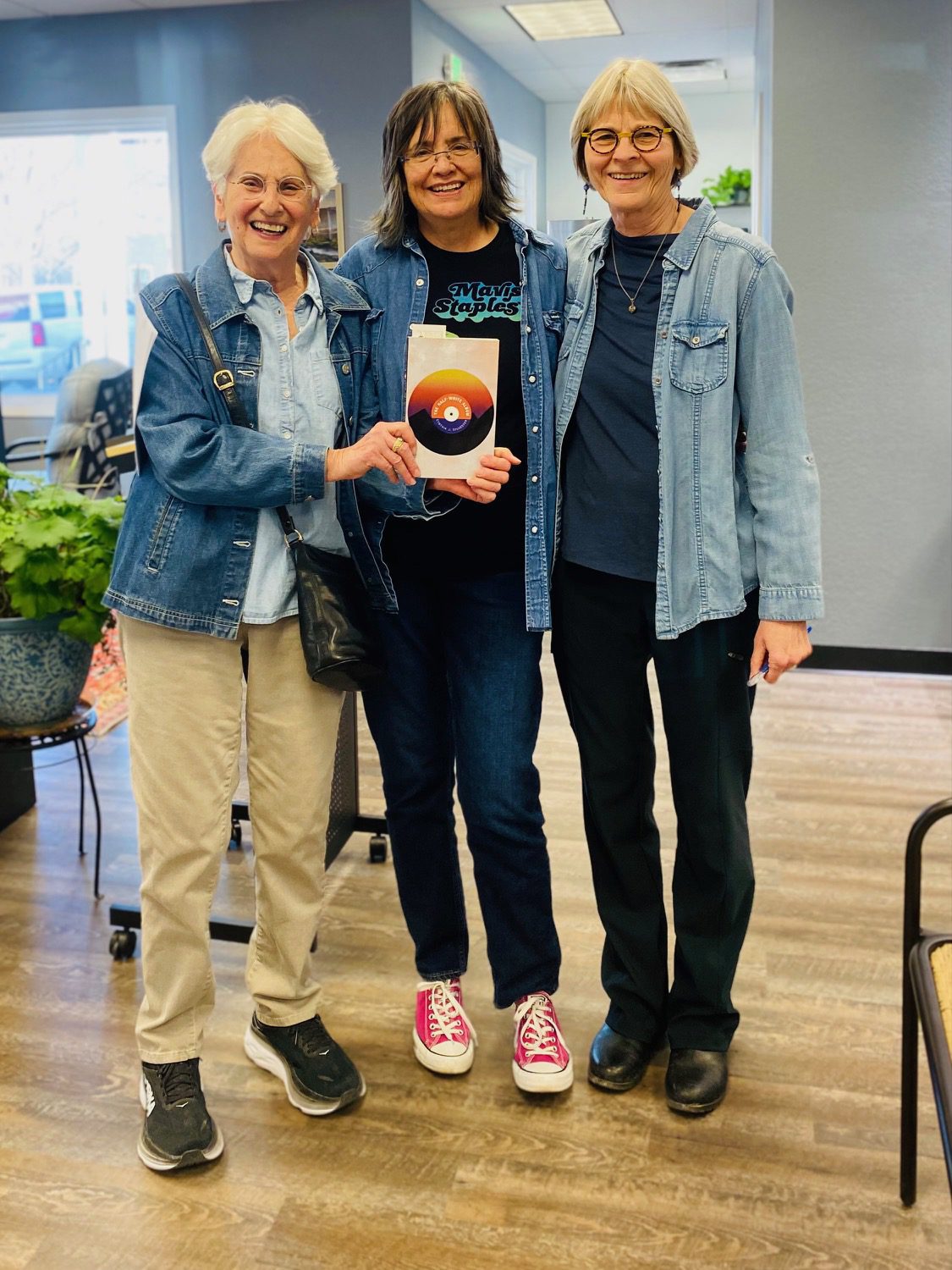
In Cynthia J. Sylvester’s debut collection, The Half-White Album, poetry, music, fact, fiction, and memories are strung together to shed light on the interconnected lives of a group of people from the Dinétah and the city of Albuquerque.
The author, an enrolled member of the Diné, born into the Kiyaa’áanii Clan for the Bilagáana Clan, and a native of Albuquerque, answers some questions about the art of leaving things unsaid, the blurred line between fact and fiction, and choosing the right epigraphs.
Read the interview below.
What is real, and what is fiction? Does it matter?
Many of my stories are based on snippets of a story or event I hear or read. For the last story in the book, I had gotten this image in my mind based on this beautiful knit skirt my mom had. It was pink, and she must have worn it when she was young, before having us kids, because it’s tiny. My mom was beautiful, and I wished I could have seen her in that. So, in the book, the narrator says, “She smiles into my imaginary camera and is captured on the back of my mind like an Indigenous Jackie O.” I had to write that story, “Wild Horses” because that line wouldn’t leave me. Turns out, that story ended up being about a dress my mom made when she was a kid.
It’s like the line came to me and then story slowly had to be filled in around it—through fact and imagination.
Does it matter what is fact or fiction? Not in this book. In real life, it does. We can’t go around lying about things. But this is a creative work. It is a place where those lines can be blurred.
Words by a wide range of artists, musicians, and writers introduce each “concert.” Could you talk about how you chose them and why?
That goes back to how the book was structured. I had a specific theme in mind in each chapter, even the prologue. For each chapter, I looked to find a writer/poet and a songwriter/music performer that spoke to that theme and at times to the book.
For instance, in the chapter, Live at the House of Red Clay, several of the stories and poems centered around the lives of two-spirit persons. It is a chapter where a band member tells the reader, “These songs are my prayer, ‘Restore my heart and body to me.'” I chose well-known two-spirit songwriter and performer Elton John and bell hooks, two-spirit author, theorist, educator, and social critic, for the epitaphs for this chapter. With the epitaphs, I also worked to have those writers and performers tell the reader and me the power of words or music. For bell hooks epitaph, she states, “…rarely, if ever, are any of us healed in isolation. Healing is an act of communion.” That has significant meaning for this book and for me.
Does it matter what is fact or fiction? Not in this book. In real life, it does. We can’t go around lying about things. But this is a creative work. It is a place where those lines can be blurred.
In the scene that deals with Ruth’s funeral, the narrator asks herself, “Now, what kind of story was that for me to tell then?” How do you decide what to leave out? Are there certain things you will not write about?
I try very hard to find the multiple facets to my characters. I do that in my life too. I’ve always believed there is good in everyone. I know some people won’t agree with that for their own good reasons. But, I try with each character to find what makes them do what they do. The thread of you don’t change teams, or loyalty is everything, is seen in “Brain Damage.” A woman who needs money has a bundle of it. She will get money from her daughter and not repay her when she can access cash. I don’t want to spoil the story, but out of loyalty, she won’t spend it. What does that say about the woman? It tells me she’s complicated and multifaceted. We don’t know most people. So, I’m saying that I leave out being mean-spirited and judging people. I may allow another character to judge them, but I, as the writer, don’t. I try and find out their motivation.
I really wanted to be a spy when I was a kid. A friend and I had a club called InSpy. Investigation and spying. I would dust the handles in our home with flour, not realizing that you do that after the person leaves the room, not before. Then I’d take Scotch tape once I saw a family member enter the bathroom or their bedroom and get their fingerprints on file. Lol I made cards and everything. My friend and I used to walk down alleys looking for clues about crimes. We’d scare ourselves silly.
So, I’ve always been interested in secrets and what lies beneath a person’s surface. But I was raised protestant for the first eleven years of my life, and I still remember a few things. The most important to me is the Golden Rule: “Judge not, lest you be judged.”
And I won’t write about something that I know, clearly, is a secret. I care more for my relationships with my people and my family than I do the story. Now I may write it in a journal but not for the public. Or I may write the traits of someone into a character. I have a children’s/middle school book I’ve been working on for years, and the villain is definitely based on someone I knew. Lol
Could you talk about the choice to leave certain stories, like that of Muriel and Jean, somewhat open-ended?
In the case of Muriel, I have written two other stories with Muriel in them. The bracelet in the story, “May This Be Love” was going to be used to link the stories in the original version of this book. That book was very different. It was a classic short story collection. I used Muriel and the bracelet to create some cohesiveness between the stories as they too place in the desert southwest and North Carolina. Muriel shows up with the bracelet again years later at the Hollywood Hills Trailer Park in a small town in North Carolina. So, she continues on, just not in this book.
Regarding Jean. Like so many people on the reservation or in reservation border towns, Jean just disappears. Was that planned? No. But is that true? Yes. I may write her, though, having a happy life somewhere. That would be good. At least she gets a way this once, right?
I had a specific theme in mind in each chapter, even the prologue. For each chapter, I looked to find a writer/poet and a songwriter/music performer that spoke to that theme and at times to the book.
Excerpt from the story, Live at the House Made of Blue Smoke, from The Half-White Album.
You’ll Think of Me
My mom carefully unwrapped and placed two dinner plates on the green tarp we’d laid out on the dusty fairgrounds turned flea market. She had gotten them by saving S&H green stamps for the first five years of her marriage. Now that she was in the third year of her divorce they were for sale. The box we brought them in had “$10.00” written on an upturned flap that blew in the late-morning breeze.
My mom and I were selling things. We felt like real old-timey Indians sitting on the back of her Ford, sipping soda and coffee and trading our things for money. There were among other things: my hand-sewn confirmation dress, a really awful green, not like the new leaves on a geranium but more like those same leaves in need of water; a lopsided table lamp; shoes that looked like our feet were still in them; and our dinnerware, originally a setting for a family of five, but now only four and mismatched, all except the teacups. That’s because they were like the paper towels that hung by the sink and were only for show.
Although it was not real china and they were not delicate, I thought they were exotic. The pattern was a cobalt-blue tranquil scene of a river, its two sides traversed by a wooden bridge with a willow hanging over the gently flowing water. I imagined just beyond the blue border of the plate there were lovers carving their initials with sharp steak knives into a tree.
As my mom and I sipped our drinks, beginning to get sunburned, a small woman holding the hand of a little boy stopped at our space and picked through the clothes, finding none that were her size or style and none for the little boy. Then she saw the plates in the cardboard box. My heart sank a little as she let go of the boy’s hand and kneeled down to take a closer look. My mom slid off the trunk of the car and went over to tell her that there was one bowl and a saucer missing. She picked up a plate and pointed out a chip, then knelt across from her, unwrapped the teacup, and handed it to the woman in the long skirt and flat shoes.
Then she handed her a saucer. The woman asked my mom something in Spanish, which we don’t speak. My mom just unwrapped another cup and tried to demonstrate that there was no saucer by placing it on her long brown hand. The woman said something else, and my mom said they were good plates.
The little boy was running in the aisle between spaces with a toy on the end of a stick like a kite. The woman spoke to him, and he came and walked around our stuff as my mom and the woman, who was probably twenty years younger, knelt with the teacups.
When I think back now on our dishes, I don’t see our family around a dinner table. I see my mom smiling at the little boy and two women kneeling on the ground like relatives. They could have been making tortillas or kneel-down bread. They could have been sitting in a park on a sunny day on a green lawn, watching their children play.
My mom ran her finger around the blue border of the saucer and said, “There’s a chip.”
I was hoping the woman would think the dishes were too old fashioned, but she made an offer of four dollars, and I countered with eight with some finality, even though they weren’t my plates, not my green stamps meticulously saved and taken in little books to a store in exchange for something beautiful to set on a table for a family.
My mother nodded at her, and together they rewrapped the newspaper around the dishes, black ink staining their fingers.
